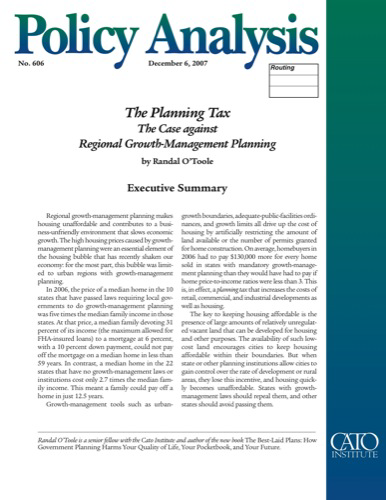No Light Rail in Vancouver!
Light rail costs too much, does too little
Anti-Sprawl Planners Caused the Housing Bubble
Easy credit fed the flame of the recent housing bubble. But, as a paper published
today by the Cato Institute shows, the flame that inflated the bubble was first ignited
by anti-sprawl plans that created artificial housing shortages in many American cities
and states. If planning had not boosted median housing prices to several times median
family incomes, few homebuyers would have had to resort to sub-prime mortgages.
Click to download the report.
The Cato paper shows that a housing bubble really only took place in a dozen or so
states. In the remaining states, increases in housing prices were relatively modest.
For example, from 2000 to 2006 prices in California and Florida grew by more than
130 percent, while prices in Texas grew by only 30 percent.
The paper also shows that, with a couple of exceptions, the states that saw the biggest
bubbles were states that had passed growth-management planning laws. With one exception,
every state that has passed such a law also saw big housing bubbles.
The exceptions were New York and Nevada (where prices grew without a growth-management
law) and Tennessee (where prices didn’t grow in spite of a 1998 growth-management
act). New York prices only grew in the New York City area, which is surrounded by
states and suburbs that have growth-management laws and plans. Nevada prices grew
because Las Vegas has literally run out of private land; it is surrounded by federal
land and federal land sales have not kept up with growth. Tennessee’s prices haven’t
grown because regional growth-management plans included lots of vacant land in their
urban-growth boundaries, so there is, as yet, no shortage.
Americans want to live in single-family homes. Anti-sprawl restrictions increase
the price of such housing. But people will go to great lengths to achieve the American
dream of homeownership, including bidding up the price of scarce housing and taking
out various sorts of sub-prime mortgages to pay for that housing.
The Cato paper estimates that anti-sprawl plans effectively imposed a $250 billion
tax on homebuyers in 2006, and 93 percent of that tax was in just eleven states,
all of which (except New York) have growth-management planning laws of one sort or
another.
The lessons should be clear: If more states pass growth-management laws, the next
bubble will have even more detrimental effects on our economy. Instead, states that
have passed such laws should begin to repeal them. Cities that have written growth-management
plans should expand or eliminate their urban-growth boundaries, eliminate impact
fees, reduce the time and red tape required to get subdivision and building permits,
and remove other planning obstacles that prevent home builders from meeting the demand
for housing.
In the last six months, the Antiplanner has prepared detailed studies of anti-sprawl
planning in Oregon, California, and British Columbia. One consistent finding is that
housing prices increase when cities get control of the rural areas that surround
them. Growth-management planning is one way, though not the only way, for that to
happen.
If developers can subdivide and build on land in rural areas, cities have to offer
a low-cost, growth-friendly environment in order to attract development (and the
resulting tax revenues) within their borders. But if cities can prevent development
outside their borders, they have no incentive to maintain growth-friendly policies,
and so they will hike impact fees and take other actions that make housing unaffordable.
Speculations that regional governments can keep housing affordable are unfounded.
In fact, because those regional governments are likely to be controlled by the cities,
such regional governments practically guarantee that housing will become unaffordable.
Of course, existing homeowners benefit when housing prices rise. But the costs to
society as a whole are much greater than these benefits. First, many homes sold each
year are new, and no one benefits from artificially high prices for these new homes.
Second, not all existing homeowners benefit: those who want to buy a larger home,
for example, will face the same obstacles that confront first-time homebuyers. Third,
there is an equity problem because existing homeowners tend to be wealthier than
homebuyers, so anti-sprawl planning effectively taxes the poor and gives the money
to the rich.
The saddest thing is that many of the states and cities with growth-management plans
consider themselves “progressive.” In truth, they are extremely regressive as they
favor wealthy homeowners and penalize low-income families and first-time homebuyers.
As the head of the Northern California Home Builders Association, Joseph Perkins
(who happens to be black) puts it, “smart growth is Jim Crow.”
Russians say that Americans don’t have real problems, so they make them up. Urban
sprawl is one of those made-up problems. In fact, the costs of sprawl are far outweighed
by the costs of anti-sprawl planning. Cities should stop doing such planning and
states should repeal laws that give cities control over the surrounding areas outside
their borders.
Reprinted from The Antiplanner

